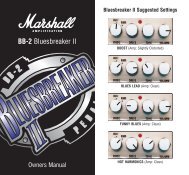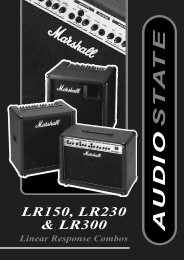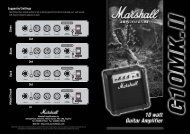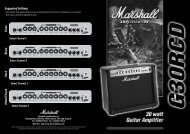AVT150X, AVT150HX & AVT275X - Marshall
AVT150X, AVT150HX & AVT275X - Marshall
AVT150X, AVT150HX & AVT275X - Marshall
You also want an ePaper? Increase the reach of your titles
YUMPU automatically turns print PDFs into web optimized ePapers that Google loves.
AdvancedValvestateTechnology<br />
<strong>AVT150X</strong>, <strong>AVT150HX</strong> & <strong>AVT275X</strong><br />
Owners Manual
From Jim <strong>Marshall</strong><br />
I would like to thank you personally for selecting one<br />
of our Valvestate AVT amplifiers.<br />
Ever since its initial launch in the early 1990’s, the<br />
original <strong>Marshall</strong> Valvestate technology received<br />
worldwide acclaim and set a new standard in affordable<br />
quality amplification. However, my dedicated team of<br />
designers are constantly looking for methods to make our<br />
amplifiers sound even better. As they are all guitar players<br />
themselves this process has become a passion within the<br />
design department.<br />
As the name Advanced Valvestate Technology (AVT) suggests,<br />
your new amplifier benefits from their research and utilises their<br />
latest circuit innovations, all of which are totally unique to<br />
<strong>Marshall</strong>. By emulating the feel and response of an all-valve<br />
amplifier even more closely, the AVT range perform brilliantly<br />
and represent yet another major step forward in guitar sound<br />
technology.<br />
I suggest that you read this manual thoroughly before operating<br />
your new amplifier and keep it in a safe place for future<br />
reference. This will help you to derive maximum enjoyment from<br />
our Advanced Valvestate Technology.<br />
Wishing you every success.<br />
Yours Sincerely,<br />
1<br />
ENGLISH
ENGLISH<br />
Introduction<br />
What is AVT?<br />
Advanced Valvestate Technology, or AVT for short, is a major step forward in hybrid amplifier design<br />
which is exclusive to our Advanced Valvestate Series of amplifiers. It has evolved from the original,<br />
critically acclaimed <strong>Marshall</strong> Valvestate technology, but is improved so that it emulates even more<br />
closely the feel and response of the classic <strong>Marshall</strong> all-valve power stage...without using valves.<br />
It is not only the power stage that has been significantly improved in the series either. Much careful<br />
attention to detail and many hours of development have also gone into the preamp section too. As a<br />
result, each AVT channel offers the widest possible range of control and shape to your sound, with an<br />
ECC83 (a.k.a.12AX7) preamp valve adding to the all-important tone and feel of these latest <strong>Marshall</strong><br />
creations.<br />
Valve Drive Preamp<br />
As just stated, each amp in the range boasts a preamp stage equipped with an ECC83 Dual Triode<br />
valve. Drawing on our vast experience in this field, we have gone to great lengths to ensure that this<br />
precious device delivers maximum sonic benefit at all settings and volume levels. As a result, the<br />
clean sounds ring with the ‘bell-like’ harmonics that only a valve preamp can deliver and the break-up<br />
is never harsh or unnatural sounding. Whenever an AVT Overdrive channel is selected the ECC83’s<br />
dual triode is saturated to its limit, providing the dynamics and feel worthy of a place in the <strong>Marshall</strong><br />
hall of fame.<br />
Power Amp Delivery<br />
The same sort of toneful care and attention was also focused on the all-important power stages of the<br />
AVT series too. Our goal was to ensure that each one would create the warm, musical feel and 3dimensional<br />
sounds that have made our all-valve power amps world renowned. In addition, these AVT<br />
products were designed to deliver the goods in the often hostile and unpredictable environment of the<br />
live performance stage - which is why all the AVT power amps, from the AVT50X upwards, are fan<br />
cooled for optimum reliability.<br />
'Extended Bass Response' Loudspeakers<br />
Knowing how important the relationship between the amplifier and speaker is, this is another area<br />
where we spent a great deal of time and effort when developing the AVT Series. By working extremely<br />
closely with our long-term colleagues at Celestion Loudspeakers, we have successfully developed a<br />
range of speakers which, through radical design, re-define the state-of-the-art in rock guitar<br />
reproduction. In a nutshell, they allow the compact closed back cabinets used in the AVT range, to<br />
maintain the bottom end delivery normally only associated with a full 4 x12 cabinet set-up.<br />
DFX Onboard<br />
At <strong>Marshall</strong> our aim is to create products that offer our fellow guitarists true inspiration in the practice<br />
and performance of their art. When integrating DFX (Digital Effects) into the tonal topology of AVT, the<br />
greatest care was taken to ensure that the highest level of signal integrity was maintained. Through<br />
careful shaping and mixing of the ‘wet’ (processed) and ‘dry’ (unprocessed) signals, we have ensured<br />
that the onboard effects enhance your tone while adding none of the nasty, artificial ‘grain’ often<br />
associated with DFX. Different effect types can be assigned to the Clean and Overdrive channels and<br />
can, of course, be turned on and off via the sturdy 6-way LED foot controller supplied with your amp.<br />
<strong>AVT150X</strong> & <strong>AVT150HX</strong> Front Panel Features<br />
I. The Preamp Section<br />
Your AVT amp boasts no fewer than four<br />
channels: Acoustic Simulator, Clean, Overdrive<br />
1 and Overdrive 2. The preamp section is where<br />
the gain, tone and relative volume of these four<br />
channels is determined.<br />
1. Input Jack Socket<br />
This is where you plug your guitar into the amp.<br />
You must always use a screened (shielded)<br />
guitar cable and never use an unscreened<br />
(unshielded) speaker cable. Also, this cable<br />
should be one of good quality. If you are in any<br />
doubt regarding this, your <strong>Marshall</strong> dealer will be<br />
more than happy to help and advise you.<br />
2. Acoustic Sim. Channel Selector Switch<br />
Allows selection of the Acoustic Simulator<br />
channel via the front panel.<br />
3. Top Control<br />
This control takes the channel’s sound from a<br />
mellow, acoustic tone (similar to a microphone<br />
placed towards the neck of the instrument) all<br />
the way to a bright, piezo-like acoustic sound<br />
and all points in-between.<br />
Note: The amp’s Master Presence control (21)<br />
affords you further adjustment of the high end.<br />
4. Body Switch<br />
This changes the ‘body resonance’ simulation of<br />
the channel from that of a regular sized, steelstring<br />
acoustic (switch ‘out’) to that of a large<br />
bodied, ‘Jumbo’ acoustic (switch ‘in’).<br />
5. Volume Control<br />
This dictates how loud the Acoustic Simulator<br />
Channel will be.<br />
8. Bright Switch<br />
Most of the Gain controls in classic <strong>Marshall</strong><br />
amps have been fitted with what is known as a<br />
‘treble bleed capacitor’. This device allows extra<br />
high frequencies to be ‘bled’ through to the drive<br />
section when the Gain control is at low settings.<br />
Engaging the Bright Switch will ‘bleed’ extra high<br />
frequencies into the drive stage of the Clean<br />
channel, giving you a bright, clean tone perfect<br />
for many styles, including funk and country.<br />
The higher the Gain control is set, the less effect<br />
the ‘treble bleed capacitor’ has. As a result, at<br />
maximum Gain settings, the bright switch will<br />
have no audible effect at all.<br />
9. Clean Volume Control<br />
As its name suggests, this control determines<br />
the volume of the clean channel. The actual<br />
setting you choose will be dependent on how<br />
loud you want the channel to be, and also on<br />
the type of sound you have selected on the preamp.<br />
Due to the remarkable realism of our<br />
Advanced Valvestate Technology, once the<br />
Volume control is turned-up past a certain point<br />
the preamp will start to push the power amp<br />
section into creating its own, desirable distortion<br />
- just like an all-valve <strong>Marshall</strong> amp. When this<br />
occurs, the AVT’s power amp will start to add<br />
musical harmonics, compression and ‘break-up’<br />
into your sound.<br />
Note: As each channel has its own volume<br />
control, you can easily balance the levels of all<br />
four channels as you so desire. Once set to your<br />
satisfaction, these controls can be left alone and<br />
you can use the amp’s Master Volume knob (20)<br />
to set your overall volume level.<br />
6. Clean Channel Selector Switch<br />
10. Clean Tone Controls<br />
The Clean channel is equipped with rotary Bass,<br />
Middle, and Treble controls. These three passive<br />
This allows selection of the Clean channel via EQ controls are designed to achieve maximum<br />
the front panel.<br />
tonal variation from your AVT amplifier and, just<br />
like the tone controls on our famous all-valve<br />
7. Clean Channel Gain Control<br />
amps, are highly inter-dependent on each other.<br />
This rotary control regulates the drive into the As a result, the way each one functions depends<br />
two cascaded valve stages of the preamp. on the exact position of the other two controls.<br />
Lower settings will give you a wide range of well This is especially true of the Bass and Treble<br />
defined, warm clean tones.<br />
controls in relation to the Middle control. As you<br />
will discover, the lower the Middle control is set,<br />
At higher Gain settings you will pass through<br />
natural, valve-induced compression and into an<br />
the more ‘reactive’ the others become.<br />
increased level of desirable ‘break-up’ (a.k.a. As tone is very much down to personal taste,<br />
‘crunch’) which is perfect for subtly overdriven experimentation and experience is probably the<br />
2<br />
blues/rock.<br />
3<br />
best way of learning how these three controls<br />
ENGLISH
ENGLISH<br />
will affect your sound. To offer you some<br />
guidance, suggested settings are shown later on<br />
in this manual.<br />
Points to remember are:<br />
When selecting a sound on any amp:<br />
a) The tone and output level coming out of each<br />
guitar is as widely variable as guitars<br />
themselves. Remember, guitars and also<br />
pickups are not designed (nor intended) to be<br />
equal. Therefore, amp settings will vary to suit<br />
both your guitar and your playing style, and by<br />
necessity, are at your discretion.<br />
b) The tone of your sound is also dependent on<br />
the way you set-up the Volume, Gain and Tone<br />
controls of your amp. Taking the time to adjust<br />
them to taste will further enhance the sonic<br />
textures of your AVT. As is true of all the best<br />
things in life, it is worth investing some time<br />
playing around until you find the desired sweet<br />
spot!<br />
Note: The amp’s Master Presence control (21)<br />
affords you further adjustment of the high end.<br />
11. OD1 Channel Select Switch<br />
Pressing this front panel switch selects the<br />
Overdrive 1 (OD1) channel of your AVT.<br />
12. OD1 Gain Control<br />
This rotary control can be best described as the<br />
‘sonic brain’ of the OD1 channel. Lower Gain<br />
settings will produce well-defined, natural<br />
sounding overdrives which have a nice ‘cut,’<br />
making them perfect for funky, blues rock.<br />
Higher gain settings will see the sound start to<br />
get more ‘rounded’ as the AVT’s pre-amp valve<br />
is pushed into saturation.<br />
13. OD1 Scoop Switch<br />
Fine tuned to create the most awesome mid<br />
‘scoop’ imaginable, OD1's Scoop circuitry is more<br />
than just a pre-set middle control. Instead it<br />
actually reconfigures the whole post-EQ voicing<br />
of the channel - from low to high. Because of this,<br />
even though the resulting ‘scooped’ sound that<br />
occurs when the switch is activated (pushed ‘in’)<br />
is totally extreme, the channel's overall tone still<br />
remains tight and focused.<br />
14. OD1 Volume Control<br />
As its name suggests, this control determines<br />
the volume of the OD1 channel. The actual<br />
setting you choose will be dependent on how<br />
loud you want the channel to be, and also on<br />
the type of sound you have selected on the pre-<br />
amp (i.e. high Gain settings will generate much<br />
more preamp output level than lower, cleaner<br />
sounding Gain settings).<br />
Due to the remarkable realism of our Advanced<br />
Valvestate Technology, once the Volume control<br />
is turned-up past a certain point, the preamp will<br />
start to push the power amp section into<br />
creating its own, desirable distortion - just like<br />
an all-valve <strong>Marshall</strong> amp. When this occurs, the<br />
AVT's power amp will start to add musical<br />
harmonics, compression and desirable ‘breakup’<br />
to your sound.<br />
As previously stated, each channel has its own<br />
volume control so you can easily balance the<br />
levels of all four channels. Once set to your<br />
satisfaction, these controls can be left alone and<br />
you can use the amp’s Master Volume knob<br />
(20) to set your overall volume level to best suit<br />
each playing situation and venue.<br />
15. OD2 Channel Select Switch<br />
This selects the Overdrive (OD2) channel of<br />
your amp.<br />
16. OD2 Gain Control<br />
Cranking the OD2 Gain control will unleash the<br />
most extreme gain levels ever found on a<br />
<strong>Marshall</strong> Valvestate amplifier. The higher<br />
settings of the OD2 gain control can be likened<br />
to driving the front-end of an already raging<br />
<strong>Marshall</strong> valve amp with a high gain, overdrive<br />
stomp box. If you've already experienced the<br />
tonal pleasure of ‘front ending’ a <strong>Marshall</strong> valve<br />
amplifier in this way, you will appreciate the<br />
energy and dynamics of this type of set-up!<br />
Turning the OD2 Gain control clockwise will see<br />
more of the already smouldering signal being<br />
sweetly compressed and ‘rounded’ by the<br />
unique characteristic of the AVT's Valve Drive<br />
stage as it is driven over the top into total<br />
saturation. This channel can also be as nasty<br />
and ‘in-yer-face’ as you would like. Engaging the<br />
OD2 ‘Scoop’ button (17) will take this channel<br />
onto a new level of cranium crushing crunch,<br />
perfect for modern (a.k.a. ‘nu’) metal.<br />
17. OD2 Scoop Switch<br />
As is true of the OD1 Scoop, this circuit acts like<br />
an advanced, pre-set contour control that not<br />
only ‘scoops-out’ the mids but also shapes the<br />
highs and lows for a tight, focused sound.<br />
Engaging OD2’s Scoop Switch loads you up<br />
with a ‘bottom heavy’ sound perfect for the detuned,<br />
high-gain aggression favoured by many<br />
modern acts.<br />
18. OD2 Volume Control<br />
This control regulates the drive of the OD2<br />
channel into the power stage of the amplifier,<br />
hence controlling its output volume. You will find<br />
that the louder you go, the looser the bottom<br />
end of your sound will become. Having said this,<br />
the closed-back cabinet design of your AVT is<br />
such that it will deliver tight, well-defined low<br />
end at much higher volumes than any other<br />
‘hybrid’ amplifier known to man.<br />
19. Overdrive Tone Controls<br />
Your AVT is equipped with rotary Bass, Middle,<br />
and Treble EQ controls which are shared<br />
between the two Overdrive Channels, OD1 and<br />
OD2. This EQ section boasts a tone circuit<br />
identical to the one used in legendary <strong>Marshall</strong><br />
valve amplifiers such as the 100 Watt ‘Plexi’ and<br />
the JCM800 2203, making it a foundation stone<br />
for that instantly recognisable and<br />
unsurpassable ‘<strong>Marshall</strong> Sound’. As was the<br />
case with the Clean channel’s EQ network,<br />
these controls are interactive and, as a result,<br />
allow endless tonal possibilities.<br />
Note: Remember that in addition to these three<br />
controls, further tonal adjustment is also<br />
afforded by the Scoop button (17) and also the<br />
Master Presence control which is explained later<br />
(21).<br />
II. The Master Section<br />
These controls adjust the power amp section of<br />
your AVT and determine the overall Volume and<br />
Presence of the amplifier.<br />
20. Master Volume<br />
Once you have set the relative volumes of your<br />
AVT's channels, this control governs the overall<br />
volume of the amplifier.<br />
21. Master Presence<br />
A feature normally only found on expensive<br />
valve amplifiers, the Presence control affords<br />
you increased high frequency control by altering<br />
the power amplifier’s feedback. Increasing the<br />
Presence control will emphasise high-end ‘fizz’<br />
in overdriven tones and top-end ‘sparkle’ in<br />
clean sounds.<br />
4 5<br />
III. FX Section<br />
A. Parallel FX Loop<br />
Your AVT boasts a rear-panel mounted Parallel<br />
FX loop for use with external effects devices.<br />
This FX loop is Mono in the case of the<br />
<strong>AVT150X</strong> and <strong>AVT150HX</strong> and Stereo (Mono<br />
Send, L & R Returns) in the case of the<br />
<strong>AVT275X</strong> (see ‘Rear Panel Features’ Section for<br />
more details).<br />
22. FX Loop Mix Controls (Clean &<br />
Overdrive)<br />
When an effects unit is hooked-up to the<br />
aforementioned FX loop, the top control adjusts<br />
the FX Mix for the two OD channels and turning<br />
it clockwise increases the amount of effect you<br />
hear - from ‘dry’ (0) to ‘wet’ (10). The bottom FX<br />
Mix control does the exact same thing for the<br />
Acoustic Simulator and Clean channels.<br />
Please note that the FX mix on your external<br />
processor should be set to maximum (i.e. ‘wet’).<br />
B. Internal Digital FX<br />
As mentioned in the introduction of this manual,<br />
the <strong>AVT150X</strong>, <strong>AVT150HX</strong> and <strong>AVT275X</strong> each<br />
feature two separate DFX (Digital Effects)<br />
sections - the upper DFX section is for the two<br />
Overdrive channels, OD1 and OD2, and the<br />
lower section is for the Clean & Acoustic<br />
Simulator Channels. Each DFX section boasts<br />
16 on-board effects and three controls - DFX<br />
Mix, Adjust and Program.<br />
We chose the particular effects algorithms to<br />
give you a comprehensive palette of natural<br />
sounding options. When developing the DFX<br />
section, our aim was to enhance the overall<br />
sound of the amplifier and, most importantly,<br />
allow the effects to work with you instead of<br />
masking your all-important tone underneath<br />
layers of artificial sounding digital signal<br />
processing.<br />
ENGLISH
ENGLISH<br />
The first 10 programs offered are all Reverbs. Reverberation effects recreate the natural echo<br />
reflections found in physical environments such as halls and rooms or, in the case of plate reverbs, a<br />
mechanically vibrating metal plate. These echoes are extremely complex in nature and are, therefore,<br />
notoriously difficult to recreate. In developing these 10 programs we've gone to great lengths to<br />
ensure that none of the harsh digital ‘graininess’ normally associated with some digital reverbs is<br />
present.<br />
Below is a brief description of each of the 16 DFX programs available:<br />
1 Hall A: this is a large, bright sounding, concert hall. “Wembley Arena, are you ready to<br />
rock!?”<br />
2 Hall B: warmer sounding than Hall A, this program is perfect for adding depth and character<br />
to clean and acoustic tones.<br />
3 Hall C: a medium sized hall with 12ms of delay before the reverb starts.<br />
4 Room 1: a hardwood studio with lots of early reflections. Perfect for acoustic type sounds.<br />
5 Room 2: perfect for adding some subtle ambience.<br />
6 Room 3: warmer sounding than Room 1, perfect for clean or acoustic work.<br />
7 Plate 1: a bright, transparent plate sound ideal for lead work.<br />
8 Plate 2: warmer sounding than Plate 1, this program is great for adding sustain, especially<br />
on clean and acoustic tunes.<br />
9 Plate 3: an accurate emulation of a vintage tube plate reverb. As this program has very little<br />
low end it is great for adding ‘cut’.<br />
10 Gated Reverb: by ‘chopping-off’ the end of the reverb’s decay ‘tail’ via a Noise Gate, this<br />
program is great for spicing-up chord stabs without cluttering up your sound.<br />
11 Chorus: splitting the signal and then mixing the dry signal with a detuned version creates this<br />
popular effect. To add to the subtle ‘widening’ this creates, the detuned signal is modulated<br />
by an LFO (Low Frequency Oscillator) which causes the detuning to vary. The result is a<br />
subtle, lush sound that is equally effective on both clean and dirty tones.<br />
12 Flange: similar to chorus but much more ‘jet’ like in nature.<br />
13 Delay: this creates an echo repeat of the original signal. The delay time is adjustable in 10<br />
millisecond (ms) increments and can be set to be as long as 1270ms which is well over 1<br />
second.<br />
14 Chorus/Room: as the name suggests, this combines Chorus and a large room Reverb.<br />
15 Chorus/Delay/Room: if program 14 isn't dramatic enough for you then this is definitely the<br />
one for you, as it adds Delay to the Chorus & Reverb mix!<br />
16 Modulation: this effect is similar to the chorus effect but is less subtle and can be used to<br />
create rotary speaker-like effects.<br />
23. DFX Mix Controls (Clean FX &<br />
Overdrive FX)<br />
These determine the level of the internal effects<br />
selected by the pair of Program controls (25).<br />
The top DFX Mix control works on the two OD<br />
channels while the bottom one works on the<br />
Acoustic Simulator and Clean channels. In<br />
general you will find that the modulation effects<br />
(e.g. Chorus, Flange) require more level than<br />
the reverbs and delays. As always, let your ears<br />
decide what is right!<br />
24. Adjust Controls (Clean FX &<br />
Overdrive FX)<br />
For each of the 16 selectable DFX a particular<br />
parameter is adjustable. For example, when a<br />
Reverb is chosen, the decay (how long the<br />
reverb will be heard before it fades away) is<br />
adjustable via this control. The ‘Program/Adjust’<br />
table (26) on the front panel of your amp lists<br />
what the Adjust control does for each of the 16<br />
programs. As was the case with the DFX Mix<br />
controls, the top Adjust control works for the two<br />
OD channels and the bottom one for the Clean<br />
& Acoustic Simulator channels.<br />
25. Program (Clean FX & Overdrive FX)<br />
These select each one of the 16 on board digital<br />
effects - the top Program control works on the<br />
two OD channels and the bottom control works<br />
for the Clean and Acoustic Simulator Channels.<br />
The DFX available include single effects such as<br />
Reverb (9 types), Delay or Chorus and also<br />
multi-FX such as Chorus/Delay/Room. To add<br />
further to the flexibility of these two DFX<br />
sections, they can be switched on and off via<br />
the sturdy, LED foot-controller which comes<br />
supplied with each amp.<br />
6 7<br />
26. Digital FX Program/Adjust Table<br />
This lists the 16 programs selectable via the<br />
Program control (25) and also indicates which<br />
parameter the Adjust control (24) modifies for<br />
each one. For added convenience, this table is<br />
shown below.<br />
27. Power Switch<br />
Wait for it...yes, this switches the amp on and<br />
off! When the amp is on the power switch is<br />
illuminated and vice-versa. Advanced power<br />
amplifier muting circuitry provides anti-thump<br />
protection on power up and down.<br />
Important Note: As is the case with an all-valve<br />
amplifier, there will be no signal heard until the<br />
amp's ECC83 preamp valve warms-up and<br />
starts to pass signal. This can take up to 15<br />
seconds so don't panic!<br />
ENGLISH
ENGLISH<br />
<strong>AVT150X</strong> & <strong>AVT150HX</strong> Rear Panel Features <strong>AVT275X</strong> Rear Panel Features<br />
1. Mains Input Connector<br />
Your AVT is provided with a detachable mains<br />
(power) lead which is connected here. The<br />
specific mains input voltage rating that your<br />
amplifier has been built for is shown on the back<br />
panel. Before connecting for the first time,<br />
please ensure that your electricity supply is<br />
compatible with your amplifier. If you have any<br />
doubt, please seek advice from a qualified<br />
technician. Your <strong>Marshall</strong> dealer will help in this<br />
respect.<br />
2. Loudspeaker Jack Sockets<br />
a) <strong>AVT150X</strong><br />
There are two speaker jacksockets on the<br />
<strong>AVT150X</strong>. The one marked Internal (8 Ohm) is<br />
where the output of the AVT power amplifier is<br />
connected to its internal 8 Ohm Celestion<br />
loudspeaker.<br />
When an extension speaker is connected to the<br />
other output (marked Extension) the full power<br />
of the 150W power amplifier is unleashed.<br />
Please note that only an extension cabinet rated<br />
at 8 Ohms should be used.<br />
This will provide a parallel load with the Internal<br />
Speaker of 4 Ohms minimum.<br />
b) <strong>AVT150HX</strong><br />
The <strong>AVT150HX</strong> has two loudspeaker outputs.<br />
The one marked ‘Extension 8Ω’ is for<br />
connection to a single 8 Ohm cabinet. The<br />
output marked ‘Extension 8/4Ω’ can either be<br />
used for connection to a second 8 Ohm speaker<br />
cabinet, or to drive a single 4 Ohm cabinet.<br />
!<br />
WARNING:<br />
Always provide the AVT with a load equal to, or<br />
greater than, 4 Ohms.<br />
Note: Two 8Ω cabinets connected in<br />
parallel = 4Ω<br />
3. Footswitch<br />
For connection of the supplied Stage Foot<br />
Controller (PEDL-10031). This sturdy 6-way<br />
<strong>Marshall</strong> footswitch allows instant selection of<br />
the 4 channels, plus the two DFX modes. It also<br />
features LEDs to indicate status.<br />
4. Headphones<br />
The headphones output is fully emulated using<br />
an improved version of the circuitry found on the<br />
industry standard JMP-1. Turning the Master<br />
Volume (20) to zero will provide silent practice.<br />
5. Emulated Line Output<br />
This jack socket carries a specially treated<br />
output signal from your AVT that accurately<br />
emulates the sonic signature of a <strong>Marshall</strong> 4x12<br />
cabinet. This unerringly accurate emulation<br />
circuitry is <strong>Marshall</strong>'s most advanced to date<br />
and was developed via countless hours of<br />
technical research, playing, listening and finetuning.<br />
This output can be used in both live<br />
performance and recording situations to achieve<br />
authentic guitar amp tones, without having to<br />
use a microphone. Turn down the Master<br />
Volume (20) for silent recording.<br />
FX Loop<br />
As already mentioned, the <strong>AVT150X</strong> and<br />
<strong>AVT150HX</strong> both boast a Mono Parallel FX loop<br />
for connection with external effects units. In<br />
addition to the FX Mix controls on the front<br />
panel (see ‘Front Panel Features’, point 22) this<br />
FX loop comprises of an FX Send jack, an FX<br />
Return jack and an FX level control button.<br />
6. FX Return<br />
For connection to the output of your external<br />
effects device.<br />
7. FX Level<br />
This should be set to match the level of the<br />
processor being used (generally -10dB for a<br />
stomp box, +4dB for a professional, rack unit).<br />
8. FX Send<br />
For connection to the input of the external<br />
device being used.<br />
* FX Loop Hints:<br />
a) Always use high quality, shielded patch<br />
cables.<br />
b) If the processor being used has an input level<br />
control, ensure it is set correctly.<br />
c) Time based effects (delays & reverbs) and<br />
modulation effects (chorus, flange, phase, etc.)<br />
are ideal for use in a Parallel FX loop.<br />
d) Certain stomp box effects such as Wah,<br />
distortion, overdrive and fuzz were designed<br />
specifically for use in front of the amp and sound<br />
best when used that way. This said, tonal beauty<br />
is in the ears of the beholder so, if such a pedal<br />
sounds great to you when used in an FX loop<br />
then go for it! Sometimes, there are no rules...<br />
1. Mains Input Connector<br />
Your AVT is provided with a detachable mains<br />
(power) lead which is connected here. The<br />
specific mains input voltage rating that your<br />
amplifier has been built for is shown on the back<br />
panel. Before connecting for the first time, please<br />
ensure that your electricity supply is compatible<br />
with your amplifier. If you have any doubt, please<br />
seek advice from a qualified person. Your<br />
<strong>Marshall</strong> dealer will help in this respect.<br />
2. Loudspeaker Jack Sockets<br />
These connect the internal loudspeakers to the<br />
stereo power amplifier outputs.<br />
WARNING:<br />
Always provide both with a load equal to, or<br />
greater than 8 Ohms.<br />
3. Footswitch<br />
For connection of the supplied stage foot<br />
controller (PEDL-10031). This sturdy 6 way,<br />
<strong>Marshall</strong> footswitch allows instant selection of<br />
the 4 channels, plus the two DFX modes. It also<br />
features LEDs to indicate status.<br />
4. Headphones<br />
The headphones output is fully emulated using<br />
an improved version of the circuitry found on the<br />
industry standard JMP-1. Turning the Master<br />
Volume (20) to zero will provide silent practice.<br />
5. Emulated Line Outputs (L, R)<br />
This pair of stereo jack sockets carries a<br />
specially treated output signal from your AVT<br />
that accurately emulates the sonic signature of a<br />
<strong>Marshall</strong> stereo 4x12 cabinet. This unerringly<br />
accurate emulation circuitry is <strong>Marshall</strong>'s most<br />
advanced to date and was developed via<br />
countless hours of technical research, playing,<br />
listening and fine-tuning. This output can be<br />
used in both live performance and recording<br />
situations to achieve authentic guitar amp tones,<br />
without having to use a microphone. Turn down<br />
the Master Volume (20) for silent recording.<br />
8 9<br />
!<br />
FX Loop<br />
As previously mentioned, the <strong>AVT275X</strong> boasts a<br />
Parallel FX loop for connection with external<br />
effects units. In addition to the FX Mix controls<br />
on the front panel (see ‘Front Panel Features’,<br />
point 22) this FX loop comprises of an FX Send<br />
jack, two FX Return jacks, Left & Right, and an<br />
FX level control button.<br />
6. FX Return Left & Right<br />
For connection with the stereo output of your<br />
external effects device - left goes to left and,<br />
wait for it, right goes to right.<br />
Note: when using a mono output device use the<br />
Right (R) FX return as indicated.<br />
7. FX Level<br />
This should be set to match the level of the<br />
processor being used (-10dB for a stomp box,<br />
+4dB for a professional, rack unit).<br />
8. FX Send<br />
For connection with the input of the external<br />
device being used.<br />
* FX Loop Hints:<br />
a) Always use high quality, shielded patch<br />
cables.<br />
b) If the processor being used has an input level<br />
control, ensure it is set correctly.<br />
c) Time based effects (delays & reverbs) and<br />
modulation effects (chorus, flange, phase, etc.)<br />
are ideal for use in a Parallel FX loop.<br />
d) Certain stomp box effects such as Wah,<br />
distortion, overdrive and fuzz were designed<br />
specifically for use in front of the amp and sound<br />
best when used that way. This said, tonal beauty<br />
is in the ears of the beholder so, if such a pedal<br />
sounds great to you when used in an FX loop<br />
then go for it! Sometimes, there are no rules...<br />
Follow all instructions and heed all warnings<br />
KEEP THESE INSTRUCTIONS !<br />
ENGLISH
ENGLISH<br />
Suggested Settings <strong>AVT150X</strong> / <strong>AVT150HX</strong> & <strong>AVT275X</strong> Suggested Settings<br />
On all the following suggested settings you will immediately notice how rich and authentic the sounds<br />
are. As you will hear, even on clean settings Advanced Valvestate Technology adds those subtle<br />
harmonics and that desirable compression which only a classic all-valve amp can normally deliver.<br />
Bright Piezo Acoustic<br />
‘Bright Piezo Acoustic’ closely simulates the sound of a piezo equipped semi-acoustic. This setting<br />
works best with the neck pickup. Adding some Chorus/Room effect (Program 14) will give a 12 string<br />
sound for folky strumming.<br />
Mellow Jumbo<br />
Engaging the Body Switch (4) and decreasing the Top control (3) will give a really full ‘Jumbo<br />
Acoustic’ type sound. Add some Hall Reverb (Program 2) for atmospheric acoustic lead work.<br />
Funky Clean<br />
A really bright clean which still maintains mid definition. This is best used in conjunction with a singlecoil<br />
neck pick-up or the neck/bridge combination on a humbucker equipped guitar. Keeping the Gain<br />
control low ensures a clean preamp signal and also helps feed extra treble through to the power<br />
amplifier for additional brightness and cut.<br />
Blues Clean<br />
Here the preamp Gain is increased and what you start to hear is pure, harmonically rich break-up and<br />
compression from the internal <strong>Marshall</strong> ECC83 preamp valve. Again the neck pick-up on a single coil<br />
guitar or the neck/ bridge combination on a humbucker-loaded guitar will deliver the warmest tones.<br />
Jazz Clean<br />
A warm rounded clean ideal for ‘comping’ and walking bass progressions.<br />
Brit Crunch<br />
Here the advantage of the separate Gain and Volume controls really comes into play. Notice how the<br />
Gain is quite low but the Volume is quite high. This is the way the old <strong>Marshall</strong> crunch sounds of the<br />
late 60’s and 70’s were created - namely by keeping the preamp pretty clean and creating the desired<br />
distortion by driving the power stage hard. With such a setting, when you back off the guitar's volume<br />
or pick lighter, you will feel and hear how the rich, clear tone of the clean sound remains.<br />
Funky Overdrive<br />
For those who wish to get lost in a purple haze, back off OD1's Gain to give extra definition and<br />
dynamics.<br />
MV Crunch<br />
This crunch is reminiscent of the first <strong>Marshall</strong> Master Volume amplifiers of the much heralded<br />
JCM800 series. The Valve Drive Preamp is driven into mild saturation, creating a big, open overdrive<br />
using the bridge position pick-up, whether single-coil or humbucker.<br />
Screaming Lead<br />
Here the Gain is cranked to the max and the mids are brought up to fatten the tone of the single<br />
notes. With these settings the rich, natural harmonic overtones that the valve introduces will be very<br />
apparent. Best with the bridge pickup.<br />
Heavy, Modern Crunch<br />
Cutting the Mids while heavily boosting the Gain, Treble and Bass gives an aggressive, modern ‘tearyer-face-off’,<br />
scooped sound. The bridge humbucker is the one to use here if you truly wanna ride the<br />
lightning...definitely not for the faint-hearted!<br />
10<br />
Bright Piezo Acoustic Mellow Jumbo Funky Clean Blues Clean Jazz Clean<br />
150<br />
150<br />
150<br />
150<br />
150<br />
Select<br />
Select Select<br />
Select<br />
Select<br />
Select<br />
11<br />
ENGLISH
ENGLISH<br />
<strong>AVT150X</strong> / <strong>AVT150HX</strong> & <strong>AVT275X</strong> Suggested Settings<br />
150<br />
150<br />
150<br />
150<br />
150<br />
Select<br />
Select<br />
Select<br />
Select<br />
Select<br />
12<br />
Brit Crunch<br />
Funky Overdrive<br />
MV Crunch<br />
Screaming Lead<br />
Heavy Modern<br />
Crunch
Power Output 150W RMS into 4Ω 2 x 75W RMS into 8Ω<br />
Potencia de salida 150W RMS sobre 4Ω 2 x 75W RMS sobre 8Ω<br />
Ausgangsleistung 150W RMS an 4Ω 2 x 75W RMS an 8Ω<br />
Puissance de sortie 150W RMS sous 4 ohms 2 x 75W RMS sous 8 ohms<br />
Main Guitar • Input Impedance 1MΩ 1MΩ<br />
Impedancia de entrada principal de guitarra 1MΩ 1MΩ<br />
Guitar Input • Eingangsimpedanz 1MΩ 1MΩ<br />
Impédance d'entrée 1MΩ 1MΩ<br />
1MΩ 1MΩ<br />
Emulated Output • Level -10dBV * see note 1 -10dBV * see note 1<br />
Nivel de salida de línea simulada -10dBV * ver nota 1 -10dBV * ver nota 1<br />
Emulated Output • Ausgangspegel -10dBV * siehe Hinweis 1 -10dBV * siehe Hinweis 1<br />
Niveau de sortie -10dBV voir note 1 -10dBV voir note 1<br />
FX Send • Level Switchable -10dBV, +4dBV * see note 2 -10dBV, +4dBV * see note 2<br />
Envío de efectos • Nivel Commutable -10dBV, +4dBu * ver nota 2 -10dBV, +4dBu * ver nota 2<br />
FX Send • Ausgangspegel (schaltbar) -10dBV, +4dBV * siehe Hinweis 2 -10dBV, +4dBV * siehe Hinweis 2<br />
Niveau de sortie d'effet • Commutable 10dBV, +4dBV * voir note 2 -10dBV, +4dBV * voir note 2<br />
Weight 28kg 16kg 34kg<br />
Peso 28kg 16kg 34kg<br />
Gewicht 28kg 16kg 34kg<br />
Poids 28kg 16kg 34kg<br />
24.2kg 28kg 15kg 16kg 27.6kg 34kg<br />
Size (mm) 607 x 550 x 290 680 x 310 x 260 680 x 550 x 290<br />
Tamaño (mm) 607 x 550 x 290 680 x 310 x 260 680 x 550 x 290<br />
Maße (mm) 607 x 550 x 290 680 x 310 x 260 680 x 550 x 290<br />
Taille (mm) 607 x 550 x 290 680 x 310 x 260 680 x 550 x 290<br />
596 607 x 515 550 x 285 290 671 680 x 271 310 x 250 260 671 680 x 515 550 x 285 290<br />
Internal Speaker • Custom Celestion 100W/12” 8Ω N/A 2 x 100W/12" 8Ω<br />
Altavoz interno • Celestion custom 100W/12” 8Ω – 2 x 100W/12” 8Ω<br />
Interner • Custom Celestion Lautsprecher 100W/12” 8Ω – 2 x 100W/12” 8Ω<br />
Haut-parleur interne (custom Celestion) 100W/12” 8Ω – 2 x 100W/12” 8Ω<br />
100W/12” 8Ω 2 x 100W/12” 8Ω<br />
Valve 1 x ECC83 (Dual Triode) 1 x ECC83 (Dual Triode)<br />
Válvula 1 x ECC83 (Triodo doble) 1 x ECC83 (Triodo doble)<br />
Röhre 1 x ECC83 (Dual Triode) 1 x ECC83 (Dual Triode)<br />
Lampe 1 x ECC83 (double triode) 1 x ECC83 (double triode)<br />
* Note 1: Recommended for connection to<br />
inputs with input impedance >20KΩ<br />
* Nota 1: Se recomienda conectar a entradas<br />
con impedancia superior a 20KΩ<br />
* Hinweis 1: Empfohlen für Inputs mit eine<br />
Eingangsimpedanz >20KΩ<br />
* Note 1: Recommandée pour une impédance<br />
d'entrée supérieure à 20KΩ<br />
<strong>AVT150X</strong> & <strong>AVT150X</strong>H <strong>AVT275X</strong><br />
* Note 2: Recommended for use with line level<br />
equipment (i.e. rack processors etc.)<br />
* Nota 2: Se recomienda utilizar con equipo con nivel<br />
nominal de línea (como procesadores de rack, etc...)<br />
* Hinweis 2: Empfohlen für die Benutzung mit<br />
Equipment auf Linepegel (z.B.Studioeffektgeräte etc.)<br />
* Note 2: Recommandée pour des niveaux de ligne<br />
de type processeur d'effets en rack.<br />
150<br />
<strong>AVT150X</strong> Combo, <strong>AVT150X</strong>H Head & <strong>AVT275X</strong> Stereo Front Panel Features<br />
11 12 13 14 15 16 17 18 19 20 22 23 24 25 26 27<br />
1 2 3 4 5 6 7 8 9 10 21<br />
<strong>AVT150X</strong> Combo, <strong>AVT150HX</strong> Head Rear Panel Features<br />
12<br />
11<br />
13 14<br />
15<br />
16<br />
10<br />
9<br />
1<br />
8<br />
2<br />
7<br />
3<br />
6<br />
5 4<br />
12<br />
11<br />
13 14<br />
15<br />
16<br />
10<br />
9<br />
1<br />
8<br />
2<br />
7<br />
3<br />
6<br />
5 4<br />
1 2 3 4 5<br />
6 7 8<br />
<strong>AVT275X</strong> Stereo Rear Panel Features<br />
1 2 3 4 5<br />
6 7 8
English<br />
* EUROPE ONLY - Note: This equipment has been tested and found to comply with the<br />
requirements of the EMC directive (Environments E1, E2 and E3 EN 55103-1/2) and the Low Voltage<br />
directive in the E.U.<br />
* EUROPE ONLY - Note: The Peak Inrush current for the <strong>AVT150X</strong>, <strong>AVT150HX</strong> & <strong>AVT275X</strong> is 32<br />
amps.<br />
Note: This equipment has been tested and found to comply with the limits for a Class B digital<br />
device, pursuant to part 15 of the FCC rules. These limits are designed to provide reasonable<br />
protection against harmful interference in a residential installation. This equipment generates, uses<br />
and can radiate radio frequency energy and, if not installed and used in accordance with the<br />
instructions, may cause harmful interference to radio communications. However, there is no<br />
guarantee that interference will not occur in a particular installation. If this equipment does cause<br />
harmful interference to radio or television reception, which can be determined by turning the<br />
equipment off and on, the user is encouraged to try to correct the interference by one or more of the<br />
following measures:<br />
◆ Reorient or relocate the receiving antenna.<br />
◆ Increase the separation between the equipment and the receiver.<br />
◆ Connect the equipment into an outlet on a circuit different from that to which the receiver is<br />
connected.<br />
◆ Consult the dealer or an experienced radio/TV technician for help.<br />
Español<br />
* SÓLO PARA EUROPA - Nota: Este equipo ha sido examinado y se ha comprobado que<br />
cumple la normativa EMC (Apartados E1, E2 y E3 EN 55103-1/2) y la normativa de Baja Tensión de<br />
la U.E.<br />
* SÓLO PARA EUROPA - Nota: La corriente de pico en el encendido del <strong>AVT150X</strong>, <strong>AVT150HX</strong> &<br />
<strong>AVT275X</strong> es de 32 amperios.<br />
Nota: Este equipo ha sido examinado y calificado como aparato digital de Clase B, de acuerdo con<br />
la parte 15 de la normativa FCC. Esta calificación fue definida para garantizar una protección<br />
razonable contra interferencias en una instalación doméstica. Este equipo genera, utiliza y puede<br />
radiar energía de radiofrecuencia y, si no se instala y utiliza de acuerdo con las instrucciones, puede<br />
producir interferencias indeseadas a las radiotransmisiones. De todas formas, no hay una garantía<br />
total de que no ocurran interferencias en ciertas instalaciones. Si este equipo produce interferencias<br />
perjudiciales a la recepción en aparatos de radio o televisión, lo cual se puede deducir observando el<br />
efecto al encender y apagar el equipo, se sugiere al usuario que intente corregir estas interferencias<br />
siguiendo una o varias de las siguientes medidas:<br />
◆ Reorientar o reubicar la antena receptora de la radio o televisión.<br />
◆ Aumentar la separación entre el equipo y el aparato receptor.<br />
◆ Conectar el equipo en un enchufe de un circuito de alimentación distinto de aquel al que va<br />
conectado el receptor.<br />
◆ Consultar con el vendedor o con un técnico experto en radio y TV.<br />
Deutsch<br />
* GILT NUR FÜR EUROPA - Hinweis: Dieses Gerät entspricht den Anforderungen der EMC<br />
Richtlinien (Anlagen E1, E2 und E3 EN 55103-1/2) und den Anweisungen für Niederspannung der<br />
E.U und wurde entsprechend getestet.<br />
* GILT NUR FÜR EUROPA - Hinweis: Die Stromspitze beim Einschalten liegt beim <strong>AVT150X</strong>,<br />
<strong>AVT150HX</strong> & <strong>AVT275X</strong> bei 32 Ampere.<br />
Die entsprechenden Grenzwerte stellen einen ausreichenden Schutz vor störenden Interferenzen<br />
beim Gebrauch im Wohnbereich sicher. Dieses Gerät generiert und arbeitet im Radiofrequenzbereich<br />
und kann eine entsprechende Strahlung aussenden. Wird das Gerät nicht entsprechend den<br />
Bedienungsanweisungen benutzt, so kann es zu Störungen beim Empfang von Radio- oder TV-<br />
Signalen kommen. Es ist grundsätzlich nicht auszuschließen, daß es bei einigen Anwendungen zu<br />
derartigen Störungen kommen kann. Sollte dies einmal der Fall sein (zur Überprüfung sollte das<br />
Gerät an- und ausgeschaltet werden) so schlagen wir die folgenden Lösungsansätze vor:<br />
◆ Positioniere die Empfangsantenne anders.<br />
◆ Vergrössere den Abstand zwischen dem Verstärker und dem Empfangsgerät.<br />
◆ Benutze einen anderen Netzanschluß für beide Geräte.<br />
◆ Konsultiere einen Händler oder geschulten Radio-Fernsehtechniker.<br />
Français<br />
* EUROPE UNIQUEMENT - Remarque: Ce matériel a été testé: il est conforme aux<br />
directives européennes EMC (Environnement E1, E2 et E3 EN 55103-1/2) et aux directives sur les<br />
appareils basse tension.<br />
* EUROPE UNIQUEMENT - Remarque: La consommation en crête du <strong>AVT150X</strong>, <strong>AVT150HX</strong> &<br />
<strong>AVT275X</strong> est de 32 ampères.<br />
Note: Cet équipement a été testé et approuvé conforme aux normes fédérales sur les appareils<br />
numériques de Classe B selon le résolution fédérale américaine. Ces limites sont désignées pour<br />
fournir une protection raisonnable contre les interférence en installation résidentielle. Cet appareil<br />
génère, utilise et peut émettre des fréquences radio et, en cas d’installation ou d’utilisation différente<br />
de ce qui est préconisé dans ce mode d’emploi, il peut entraver la bonne réception des équipements<br />
de télévision ou radio avoisinants. Cependant, nous ne pouvons garantir l’absence d’interférences<br />
selon l’application utilisée. Si cet appareil est source d’interférence (vérifiez en plaçant l’appareil sous<br />
ou hors tension à plusieurs reprises), nous vous encourageons à appliquer l’une des mesures<br />
suivantes:<br />
◆ Réorientez ou déplacez l’antenne de réception.<br />
◆ Augmentez la distance entre l’appareil et le récepteur.<br />
◆ Connectez le matériel sur une ligne secteur différente de celle du récepteur.<br />
◆ Consultez votre revendeur ou un spécialiste TV/Radio.<br />
66 67


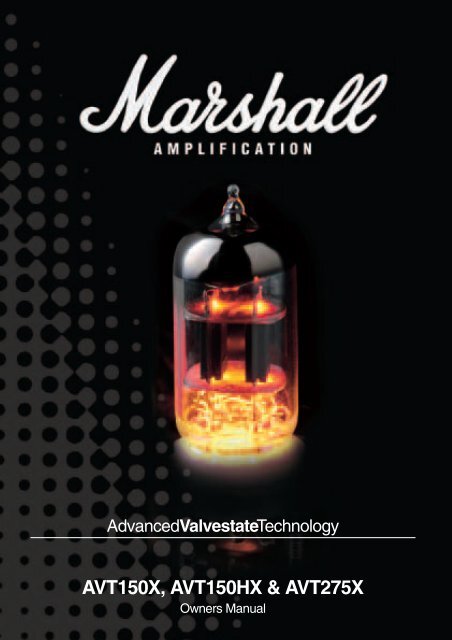


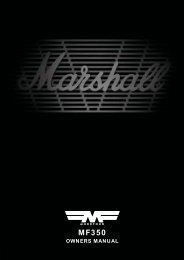
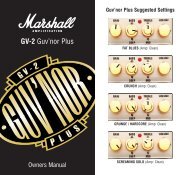

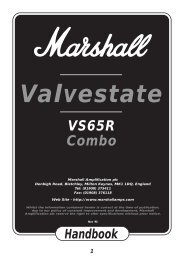
![AVT100X [2.16 MB] - Marshall](https://img.yumpu.com/11365367/1/184x260/avt100x-216-mb-marshall.jpg?quality=85)

